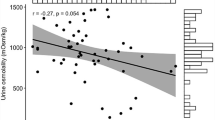Summary
Changes in body condition ofUromastix acanthinurus are closely related to climatic factors and influenced by habitat vegetation.
-
1.
The body mass index decreases significantly during the dry season and the contents of the digestive tract are responsible for most of these variations.
-
2.
U. acanthinurus achieves a large total body water volume (75.4% adjusted body mass) by accumulating extracellular fluid (33% body mass) and maintains a normal level of hydration during the dry season. Total body water decreases during this period (due essentially to diminution of extracellular fluid) but blood volume and plasma volume are almost unaffected.
-
3.
During spring there is an increase in body solids, essentially as fat reserves.
-
4.
The electrolyte balance also exhibits seasonal variations. Plasma sodium concentration increases significantly during the dry period, in relation to the decrease of extracellular fluid. Return to normal values after rainfall results from intake of a diet low in sodium. Plasma potassium shows only random variation and appears to be regulated by excretion via the nasal salt gland and in cloacal pellets.
-
5.
Under field conditions, changes in the internal environment appear more pronounced in the Saharan Agamid,Uromastix acanthinurus than in its analog, the North American Iguanid,Sauromalus obesus.
Similar content being viewed by others
References
Bradshaw SD (1970) Seasonal changes in the water and electrolyte metabolism ofAmphibolurus lizards in the field. Comp Biochem Physiol 36:689–719
Bradshaw SD (1981) Osmoregulation in a field population of desert lizards:Amphibolurus nuchalis at Shark Bay in Western Australia. Physiol Zool (in press)
Bradshaw SD, Shoemaker VH (1967) Aspect of water and electrolyte changes in a field population ofAmphibolurus lizard. Comp Biochem Physiol 20:855–865
Dubuis A, Faurel L, Grenot C, Vernet R (1971) Sur le régime alimentaire du Lézard saharienUromastix acanthinurus Bell. CR Acad Sci [D] (Paris) 273:500–503
Dunson WA (1974) Salt gland secretion in a mangrove monitor lizard. Comp Biochem Physiol [A] 47:1245–1255
Gabe M, Saint Girons H (1976) Contribution à la morphologie comparée des fosses nasales et de leurs annexes chez les Lépidosauriens. mém Mus Nat Hist Nat [A] 98:1–98
Grenot C (1968) Sur l'excrétion nasale de sels chez le Lézard saharienUromastix acanthinurus. CR Acad Sci [D] (Paris) 266:1871–1874
Grenot C (1976) Ecophysiologie du Lézard saharienUromastix acanthinurus Bell 1825 (Agamidae herbivore). Publ Lab Zool ENS 7:323
Grenot C, Vernet R (1973) Sur une population d'Uromastix acanthinurus Bell isolée au milieu du Grand Erg Occidental (Sahara algérien). CR Acad Sci [D] (Paris) 270:1349–1352
Hillman PE, Pough FH (1976) Salt excretion in a beach lizard (Ameriva quadrilineata, Teiidae). J Comp Physiol 109:169–175
Lemire M (1978) Une voie signulière d'élimination ionique: la glande nasale (à sels) chez les Lézards déserticoles herbivores. 103ème Congr Nat Soc Sav, Sc, Nancy 3:187–199
Lemire M, Grenot C, Vernet R (1979) La balance hydrique d'Uromastix acanthinurus Bell (Sauria, Agamidae) au Sahara dans des conditions semi-naturelles. CR Acad Sci [D] (Paris) 288:359–362
Lemire M, Grenot C, Vernet R (1980a) Balance hydrique du Lézard agamidéUromastix acanthinurus au Sahara nord-occidental. Bull Soc Zool Fr 105:261–264
Lemire M, Vernet, R, Grenot C (1980b) Electrolyte excretion by the nasal gland of an herbivorous Saharan lizard,Uromastix acanthinurus (Agamidae). Effects of single NaCl and KCl loads. J Arid Environ 3:325–330
Minnich JE (1970) Water and electrolyte balance of the desert iguana,Dipsosaurus dorsalis, in its natural habitat. Comp Biochem Physiol 35:921–933
Minnich JE (1972) Excretion of urate salts by reptiles. Comp Biochem Physiol [A] 41:535–549
Nagy KA (1972) Water and electrolyte budgets of a free-living desert lizardSauromalus obesus. J Comp Physiol 79:39–62
Nagy KA, Costa DP (1980) Water flux in animals: analysis of potential errors in the tritiated water method. Am J Physiol 238:454–465
Norris KS, Dawson WR (1964) Observations on the water economy and electrolyte excretion of chuckwallas (Lacertilia, Sauromalus). Copeia 1964:638–646
Shoemaker VH, Nagy KA, Bradshaw SD (1972) Studies on the control of electrolyte excreton by the nasal gland of the lizardDipsosaurus dorsalis. Comp Biochem Physiol [A] 42:749–757
Templeton JR (1964) Nasal salt secretion in terrestrial lizards. Comp Biochem Physiol 11:223–229
Templeton JR (1966) Responses of the lizard nasal gland to chronic hypersalemia. Comp Biochem Physiol 18:563–572
Templeton JR (1967) Nasal salt gland excretion and adjustment to sodium loading in the lizardCtenosaura pectinata. Copeia 1967:136–140
Author information
Authors and Affiliations
Rights and permissions
About this article
Cite this article
Lemire, M., Grenot, C. & Vernet, R. Water and electrolyte balance of free-living Saharan lizards,Uromastix acanthinurus (Agamidae). J Comp Physiol B 146, 81–93 (1982). https://doi.org/10.1007/BF00688720
Accepted:
Issue Date:
DOI: https://doi.org/10.1007/BF00688720



